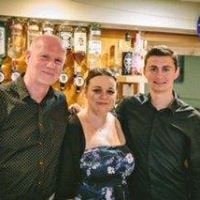In Britain there are several well preserved Roman mosaics in their original locations. One of these features Orpheus prominently; it is thought that this might have been a place for worshipping him. Where Is this mosaic?
Rural Wiltshire is rich in Roman remains, especially around nearby Swindon. The Littlecote settlement might have started as a small military base protecting a nearby river crossing. Circular farming huts were built around AD 70, relics of this time indicate baking ovens, malting tanks and grinding stones. This was succeeded (around 170 AD) by a large two-storey villa with bath suite. This building continued to evolve, with a major rebuilding around AD 270. The villa had a number of mosaics; there were also workshops, barns and a huge gatehouse.
By AD 360 the building had religious uses, rather than farming. A triconch hall was built alongside a courtyard (with its own bath suite). Such grand rooms were usually found as throne rooms in Roman or Byzantine palaces. The Orpheus mosaic was laid on the floor of the hall; it is usually interpreted in complicated pagan terms involving not only Orpheus, but also Bacchus and Apollo, the hall being seen as a cult centre for these two gods.
Many of the buildings were demolished or fell into decay around AD 400, shortly after the legislation against paganism and before the Roman withdrawal from Britain.
Although these remains with the mosaic were rediscovered in 1730 (with a coin hoard, thought to be AD 69-79), the area was only excavated from 1978 onward.
Littlecote House is rich in history; it is now a hotel, so you can visit! (Nearest town Hungerford)
More Info:
www.timetravel-britain.com










